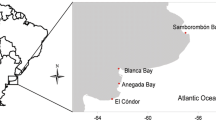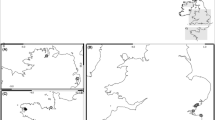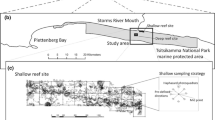Abstract
Since 2006, the Pacific oyster Crassostrea gigas has been a permanent resident on the west cost of Sweden. Because C. gigas is nonindigenous in Scandinavia, it may modify ecosystems and affect the resident biota. Individuals of C. gigas often settle in large aggregations, and the physical structure of the resulting reef provides attachment points and refuges for many secondary species. However, C. gigas also has the potential to change the macrofaunal community structure of the associated sediment, for example by stabilization or enrichment of the sediment. Here, we assess the macrozoobenthos community of sediments within C. gigas reefs and contrast the results with the comparable community within beds of the native blue mussel (Mytilus edulis) and with that of uniform bare sediment. We show that the communities within oyster reefs and mussel beds contained more species and had a higher abundance of organisms compared with the bare sediment. In addition, we show significant differences between the communities within oyster reefs and mussel beds and consistently a larger total abundance in the former.




Similar content being viewed by others
References
Anderson JM (2001) A new method for non-parametric multivariate analysis of variance. Austral Ecol 26:32–46
Anderson JM, Willis TJ (2003) Canonical analysis of principal coordinates: a useful method of constrained ordination for ecology. Ecology 84:511–525
Anderson LC, Hartmen JH, Wesselingh F (2006) Close evolutionary affinities between freshwater corbulid bivalves from the Neogene of Western Amazonia and Paleogene of the Northern Great Plains, USA. J South Am Earth Sci 21:28–48
Broekhuizen N, Zeldis J, Stephens SA, Oldman JW, Ross AH, Ren J, James MR (2002) Factors related to the sustainability of shellfish aquaculture operations in the Firth of Thames: a preliminary analysis. Unpublished NIWA Client Report EVW02243 for Environment Waikato & Auckland Regional Council
Castel J, Labourg P-J, Escaravage V, Auby I, Garcia ME (1989) Influence of seagrass beds and oyster parks on the abundance and biomass patterns of meio- and macrobenthos in tidal flats. Estuar Coast Shelf Sci 28:71–85
Crooks JA (2002) Characterizing ecosystem-level consequences of biological invasions: the role of ecosystem engineers. Oikos 97:153–166
Dahlback B, Gunnarsson LAH (1981) Sedimentation and sulfate reduction under mussel culture. Mar Biol 63:269–275
Dame RF (1996) Ecology of marine bivalves: an ecosystem approach. CRC Press, Boca Raton (FL)
Drinkwaard A (1999) Introductions and developments of oysters in the North Sea area: a review. Helgolander Meeresuntersuchungen 52:301–308
Escapa M, Isacch JP, Daleo P, Alberti J, Irribarne O, Borges M, Dos Santos EP, Gagliardini DA, Lasta M (2004) The distributions and ecological effects of the introduced pacific oyster Crassostrea gigas (Thunberg, 1793) in northern Patagonia. J Shellfish Res 23:765–772
Gilbert F, Souchu P, Bianchi M, Bonin P (1997) Influence of shellfish farming activities on nitrification, nitrate reduction to ammonium and denitrification at the water–sediment interface of the Thau lagoon, France. Mar Ecol Prog Ser 151:143–153
Glancy TP, Frazer TK, Cichra CE, Lindberg WJ (2003) Comparative patterns of occupancy by decapod crustaceans in seagrass, oyster, and marsh-edge habitats in a northeast Gulf of Mexico estuary. Estuaries 26:1291–1301
Grabowski JH (2005) How habitat setting influences restored oyster reef communities. Ecology 86:1926–1935
Green DS, Crowe TP (2014) Context- and density-dependent effects of introduced oysters on biodiversity. Biol Invasions 16:1145–1163
Green DS, Boots B, Crowe TP (2012) Effects of non-indigenous oysters on microbial diversity and ecosystem functioning. PLoS ONE 7:e48410
Green DS, Rocha C, Crowe TP (2013) Effects of non-indigenous oysters on ecosystem processes vary with abundance and context. Ecosystems 16:881–893
Grenz C (1989) Quantification et de la biodeposition en zones de production conchylicole intensive en Mediterranee. PhD thesis, Universite d’Aix- Marseille II. pp 144
Jones CG, Lawton JH, Shachak M (1994) Organisms as ecosystem engineers. Oikos 689:373–386
Kingsley-Smith PR, Joyce RE, Arnott SA, Roumillat WA, McDonough CJ, Reichert MJM (2012) Habitat use of intertidal eastern oyster (Crassostrea virginica) reefs by nekton in South Carolina estuaries. J Shellfish Res 31:1009–1021
Kochmann J, Buschbaum C, Volkernborn N, Reise K (2008) Shift from native mussels to alien oysters: differential effects of ecosystem engineers. J Exp Mar Biol Ecol 364:1–10
Lu L, Grant J (2008) Recolonization of intertidal infauna in relation to organic deposition at an oyster farm in Atlantic Canada—a field experiment. Estuaries and Coasts 31:767–775
Mann R, Burreson EM, Baker PK (1991) The decline of the Virginia oyster fishery in Chesapeake Bay: considerations for introduction of a non endemic species, Crassostrea gigas (Thunberg, 1793). J Shellfish Res 10:379–388
Markert A, Wehrmann A, Kröncke I (2010) Recently established Crassostrea-reefs versus native Mytilus-beds: differences in ecosystem engineering affects the macrofaunal communities (Wadden Sea of Lower Saxony, southern German Bight). Biol Invasions 12:15–32
McKindsey CW, Thetmeyer H, Landry T, Silvert W (2006) Review of recent carrying capacity models for bivalve culture and recommendations for research and management. Aquaculture 261:451–462
McKindsey CW, Archambault P, Callier MD, Olivier F (2011) Influence of suspended and off-bottom mussel culture on the sea bottom and benthic habitats: a review. Can J Zool 89:622–646
Norling P, Kautsky N (2008) Patches of the mussel Mytilus sp. are islands of high biodiversity in subtidal sediment habitats in the Baltic Sea. Aquat Biol 4:75–87
Padilla DK (2010) Context-dependent impacts of a non-native ecosystem engineer, the Pacific oyster Crassostrea gigas. Integr Comp Biol 50:213–225
Quan WM, Humphries AT, Shen XQ, Chen YQ (2012) Oyster and associated benthic macrofauna community development on a created intertidal oyster (Crassostrea ariakensis) reef in the Yangtze River estuary. China J Shellfish Res 31:599–610
Quan WM, Zheng L, Li B, An C (2013) Habitat values for artificial oyster (Crassostrea ariakensis) reefs compared with natural shallow-water habitats in Changjiang River estuary. Chin J Oceanol Limnol 31:957–969
Quinn GP, Keough MJ (2002) Experimental design and data analysis for biologists. Cambridge University Press, Cambridge
R Core Team (2013). R: A language and environment for statistical computing. R Foundation for Statistical Computing, Vienna, Austria. ISBN 3-900051-07-0. http://www.R-project.org/
Ruesink JL, Lenihan HS, Trimble AC et al (2005) Introduction of non-native oysters: ecosystem effects and restoration implications. Annu Rev Ecol Evol Syst 36:643–689
Shatkin G, Shumway SE, Hawes R (1997) Considerations regarding the possible introduction of the Pacific oyster (Crassostrea gigas) to the Gulf of Maine: a review of global experience. J Shellfish Res 16:463–477
Strand Å, Blanda E, Bodvin T, Davids JK, Jensen LF, Holm-Hansen TH, Jelmert A, Lindegarth S, Mortensen S, Moy FE, Nielsen P, Norling P, Nyberg C, Christensen HT, Vismann B, Holm MW, Hansen BW, Dolmer P (2012) Impact of an icy winter on the Pacific oyster (Crassostrea gigas Thunberg, 1793) populations in Scandinavia. Aquat Invasions 7:433–440
Zimmerman R (1989) Oyster reef as habitat for estuarine macrofauna. U.S. Department of Commerce, National Oceanic and Atmospheric Administration Technical Memorandum NMFS-SEFC-249. Silver Spring, Maryland
Acknowledgments
J.H. was funded by a Marie Curie European Reintegration Grant (PERG08-GA-2010-276915) and the Royal Physiographic Society in Lund. Å.S. thanks the Swedish Agency for Marine and Water Management (former Swedish Environmental Protection Agency) for funding through Havsmiljöanslaget Dnr. 309-1719-09 and Wåhlströms foundation for financial support. In addition, we thank David Reid for valuable discussion and comments on the manuscript, as well as Mats Lindegarth and Anders Nilsson for statistical advice. We thank two anonymous referees for valuable comments on the manuscript.
Author information
Authors and Affiliations
Corresponding author
Additional information
Communicated by F. Bulleri.
Rights and permissions
About this article
Cite this article
Hollander, J., Blomfeldt, J., Carlsson, P. et al. Effects of the alien Pacific oyster (Crassostrea gigas) on subtidal macrozoobenthos communities. Mar Biol 162, 547–555 (2015). https://doi.org/10.1007/s00227-014-2604-6
Received:
Accepted:
Published:
Issue Date:
DOI: https://doi.org/10.1007/s00227-014-2604-6




